| Please note that these pages are from our old (pre-2010) website; the presentation of these pages may now appear outdated and may not always comply with current accessibility guidelines. |
| Please note that these pages are from our old (pre-2010) website; the presentation of these pages may now appear outdated and may not always comply with current accessibility guidelines. |
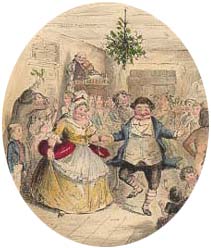
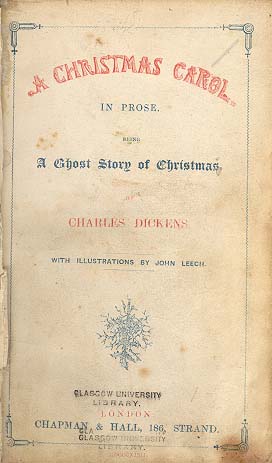 title-page |
The December book of the month is a
first edition of that festive season favourite, A Christmas Carol.
Already the successful author of Sketches by Boz, Pickwick Papers, Oliver Twist, Nicholas Nickleby, The Old Curiosity Shop, Barnaby Rudge and American Notes, Charles Dickens (1812-1870) was one of the best-loved novelists of the time when he wrote this short novel, which was completed in a mere six weeks in tandem with the production of the eleventh episode of the serially published Martin Chuzzlewit. Originally published on 17 December 1843, the book was rapturously reviewed and became an instant success, the first 6,000 copies of its initial print-run being sold out by Christmas, with 2,000 further copies from the second printing snapped up by the 6th of January. While obviously enormously popular from the outset, it has remained Dickens's most widely enjoyed work, with hundreds of further reprints and adaptations.
|
| Dickens was completely responsible for the
entire production of the book, and he commissioned John Leech (1817-1864) to
produce four hand coloured etchings and four wood engravings to illustrate
the volume.
Leech had become an artist to support himself after the bankruptcy of his family forced him to abandon the medical studies in which he had excelled in anatomical drawing. He joined the staff of Bentley's Miscellany in 1840, and was the chief cartoonist for Punch from 1841-1861: approximately 3,000 drawings of his appeared in Punch during this period. Although most famous as an early Victorian satirist for this work, he also made extensive contributions to periodicals such as The Illustrated London News and produced drawings and etchings for numerous novels, short stories and children's books. As well as those for A Christmas Carol, his best known book illustrations are found in the hunting novels of Surtees.
|
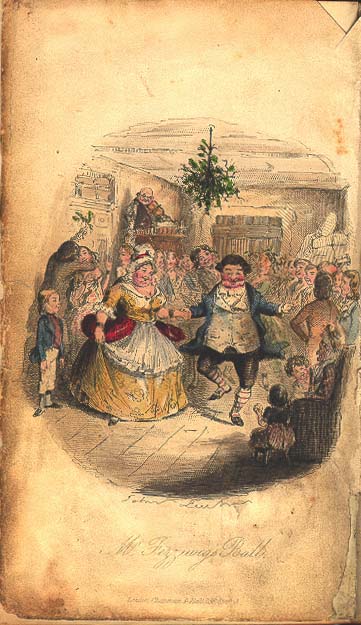 frontispiece: Mr. Fezziwig's Ball |
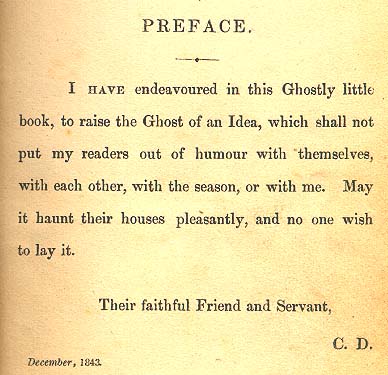 |
As in his previous novels, real social concern motivated Dickens to write A Christmas Carol. In this instance, he was inspired to write a Christmas story highlighting the plight of the poor as an appeal for charity from those better-off . Such charity was desperately needed during the severe economic depression of the 1840s. Having suffered considerable hardship and poverty during his upbringing, the passionate feelings evoked in Dickens' writings by social inequalities were based on bitter experience. Indeed, it is suggested that the Cratchit's house is modelled on the small four-room house at 16 Bayham Street in Camden Town where Dickens lived at the age of ten: the six Cratchit children correspond to the Dickens children of that time, the character of Tiny Tim being echoed in Charles's youngest, sickly brother who was known as "Tiny Fred". |
| But sheer necessity as well as altruism was
also a major factor in the creation of A Christmas Carol. Dickens'
current serial, Martin Chuzzlewit, was selling badly and he was
consequently being threatened by his publishers with a reduction in salary:
in debt, and with his wife expecting their fifth child, royalties from a
bestseller were required to bring in money quickly. However, despite the
very favourable sales of the book, the sale price of five shillings was not
sufficient to make a profit considering the expense of its production: this
was largely Dickens' fault in commissioning eight illustrations (four of
which were to be hand coloured) and insisting upon lavish end-papers and a
coloured title-page. Bitterly frustrated in his great expectations of a
massive revenue, Dickens unfairly blamed his publishers Chapman and Hall;
following his next contracted work, The Chimes, he broke off
relations with them altogether and published elsewhere for the following
fifteen years. Dickens was further blighted by the novel when a blatant piracy called Parley's Illuminated Library led to his involvement in an unsatisfactory legal wrangle. |
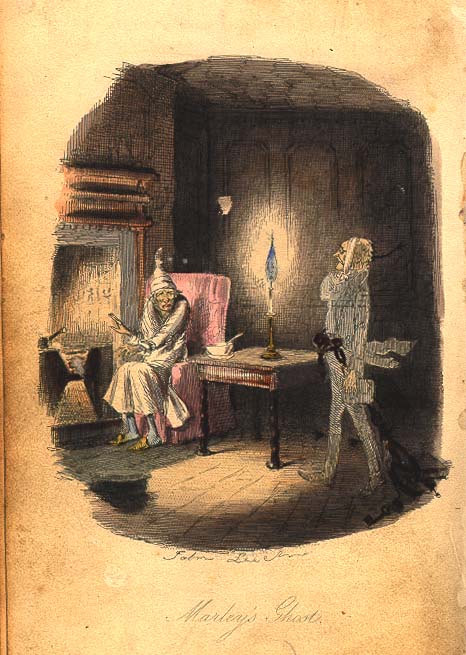 plate facing p.25: Marley's Ghost |
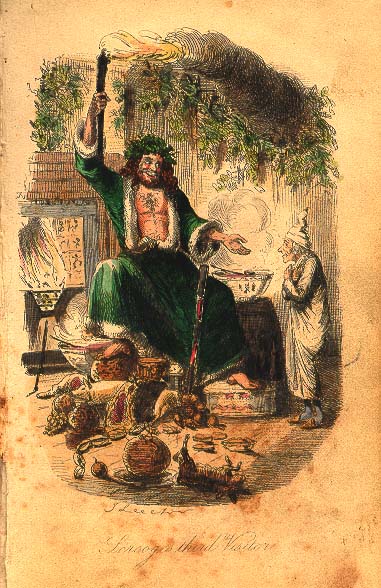 plate opposite p.78: the Ghost of Christmas Present |
Despite his personal
disappointment with the book, Dickens had in fact created a new literary
genre in the Christmas story, and he went on to produce four similar
seasonal publications for the Christmas market. Of these, The Chimes
most closely resembles the Carol formula in being set on New Year's
Eve and having a crucial supernatural element. The other three (The
Cricket on the Hearth, The Battle of Life and The Haunted Man)
all share the Carol's emphasis on family love and the delights of
the home.
wood engraving on p.73: Scrooge struggles with the ghost of Christmas Past
|
|
wood engraving on p.164: Scrooge discusses affairs with Bob Cratchit over a bowl of smoking bishop |
None of Dickens' other novels have entered
the general consciousness as much as A Christmas Carol with its
pervasive vision and philosophy of Christmas as a family feast. On its
publication, its sentiments immediately endeared Dickens to the public and
his name has been irrevocably associated with celebrating Christmas ever
since. Undeniably sentimental, its intimacy of tone and many comic touches
ensures its enduring popularity. and it was always said of him, that he knew how to keep Christmas well, if any man alive possessed that knowledge. May that be truly said of us, and all of us! |
Other items of interestOther early editions of Dickens in Special Collections: American Notes (1842) Sp Coll 922-923; Barnaby Rudge (1866) Z6-n.7; Bleak House (1852-53: in original parts, unbound) Hepburn 186-203; The cricket on the hearth (1846) Sp Coll 920; Dombey & Son (1848) Hepburn 206 and RB 2781; Martin Chuzzlewit (1844) Hepburn 208; Nicholas Nickleby (1839) Sp Coll 921 and RB 2782; Little Dorrit (1857) Hepburn 207; Mystery of Edwin Drood (1870) Sp Coll q194; Our Mutual Friend (1865) Hepburn 204-205; Pickwick Papers RB 2783 (with 82 extra illustrations) and Hepburn 209; Household Words: a weekly journal conducted by Charles Dickens (1850-59) 19 volumes at Z10-n.1-19, with special Christmas editions at Sp Coll q195 and Sp Coll q196 The bookplate of Charles Dickens is in a copy of Douce's Dance of Death at Gemmell 34; a letter from Charles Dickens, dated 22nd Nov. 1858, to Robert McGear Esq. (about the Rectorship of Glasgow University) is at Ms Gen 500 (12)
|
|
Return to main Special Collections Exhibition Page Julie Coleman December 1999
|